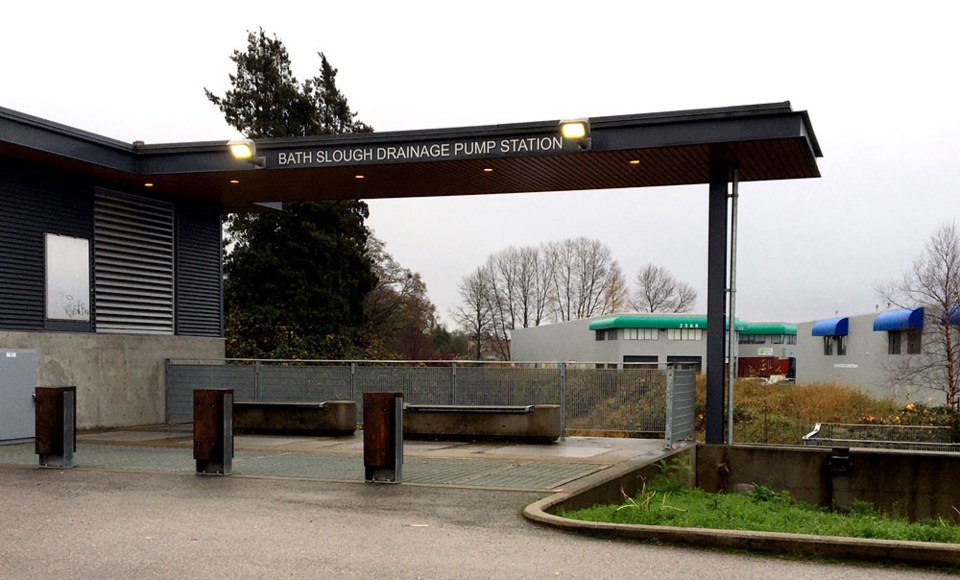Richmond deserves some credit — but as a bigger city with a lot of resources, it’s also lucky.
The city’s low-lying geography puts it at particular risk for flooding, yet it has fared remarkably well through the recent storms that have all but washed out other communities, ripped out chunks of critical highways and even changed the course of one river.
Part of the reason Richmond has stayed relatively dry and flood-free has to do with a provincial and federal funding system that rewards better-resourced cities, thus creating “have and have not” communities, according to a flood management expert.
Twenty years ago, when the province downloaded responsibility for dyking onto municipalities, the City of Richmond created a plan, established a utility to fund it and has moved forward strengthening and raising its dykes and pump stations in anticipation of sea level rise and a possible earthquake.
“Richmond has a very strong engineering department, and, from my understanding, they’re on top of the best (available) science,” said Lilia Yumagulova, who did her PhD at UBC in flood management in Metro Vancouver.
Other municipalities haven’t been so lucky, partly because of the competitive nature of securing big dollars from senior levels of government.
Currently, municipalities compete for funding from senior governments on a “merit-based” system, but this means well-resourced municipalities have more expertise and staff to write grant applications as well as money to co-finance projects.
Earlier this year, the federal government dedicated $1.375 billion over 12 years to the Disaster Mitigation and Adaptation Fund (DMAF) — and Richmond has applied for $38 million to upgrade sections of its dykes and four pump stations. These grants, if successful, would cover 40 per cent of the cost of the upgrades while Richmond would have to come up with 60 per cent — to the tune of $58 million.
But a smaller municipality — like Princeton or Merritt — is not going to have the same resources and staffing as a city like Richmond to apply for that kind of funding.
Yumagulova said funding should be “risk-based.” That would assess which municipalities are more vulnerable — rather than being based on who can write better grant applications.
“This problem of competitive funding where municipalities have to do all the homework, apply for funding and co-finance the flood protection has been a major issue in the province,” Yumagulova said.
In light of B.C.’s recent flood-related disasters, Premier John Horgan announced last week the province plans to oversee dyking on the Fraser River — something that was welcome news to Richmond’s engineering staff.
This is something Richmond city staff have been calling for, said John Irving, general manager of engineering and public works, and would work if the province set out the rules, provided steady funding but left planning to local authorities.
Because communities often have different challenges, accountability and responsibility should be at the local level with support from the provincial and federal governments, he added.
Each community knows its own local needs in the “complicated process” of putting in large infrastructure that could possibly conflict with private property.
“That’s what local governments are designed to address — if the will and focus is there, they’re very good at doing it,” Irving said.
With stable funding, smaller towns and dyking authorities could use this to plan their flood protection, even with small engineering departments.
Despite a defunding of dyke management in B.C. over the past two decades, “exceptional work” has been done by provincial public servants to identify key issues around flooding, Yumagulova said.
But to be implemented, it will need coordination between senior levels of government and sustained funding that is divorced from politics, she added, as well as convincing people it’s as important as other public policy issues, like health care.
“Historically we’ve seen massive movements after events in British Columbia where the feds and the province got together and put pockets of funding and did great things,” Yumagulova said.
Beyond engineering solutions
The “elephant in the room” is climate change, Yumagulova said, and that means thinking differently about flood solutions.
Dyking used to be the “silver bullet” solution to flooding, Yumagulova said, what she calls a “1960s engineering solution” but it’s not currently the only solution.
In fact, the B.C. Flood Strategy Discussion Paper, just published in June, talks about “flood avoidance” and “flood accommodation” to lower risks.
Flood avoidance refers to not building in areas at risk of flooding, or allowing rivers to expand and contract in channels. Accommodating floods could include allowing agricultural areas to flood periodically, elevating buildings above flood levels — something done in new construction in Richmond — or simple things like investing in sump pumps and backwater valves.
Richmond has some “nature-based” plans to protect against floods as well, Irving said. One key piece is re-establishing a natural barrier to stop storm surges on Sturgeon Banks, Irving said, something that also protects the area which is a feeding ground for birds. The aim is to create solutions that enhance environmental assets which, in turn, provide flood protection, Irving explained.
Flood risk is something citizens need to think about — and be engaged in — even when the rain stops falling, Yumagulova said. “That’s why we as a public have a huge role to play in this… being interested in it when it’s not raining, when the skies are blue.”


